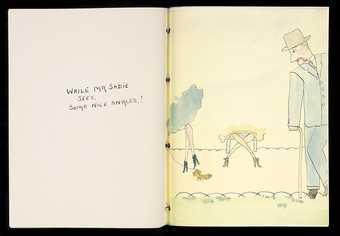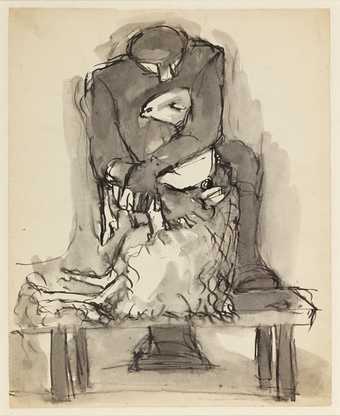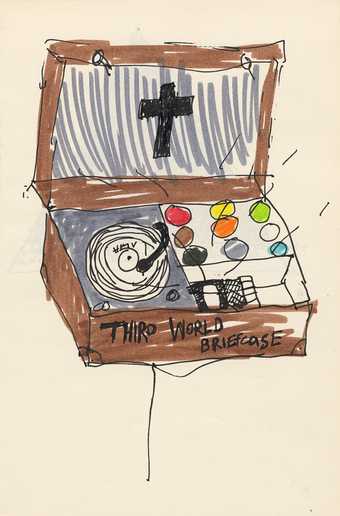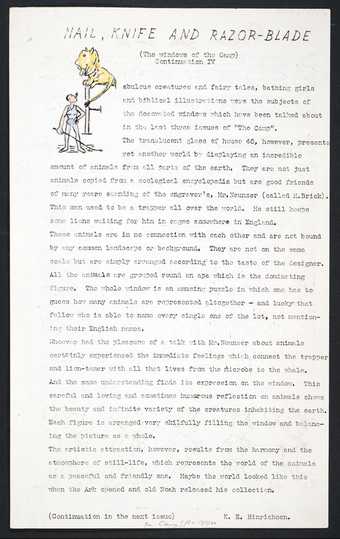
Elisabeth CollinsWhile Mr Sadie sees some nice ankles! taken from the sketchbook ‘About Mr and Mrs Sadie’ c1935TGA 200015/2/2/3/1© Tate
Opening up the riches of artists’ personal archives held at Tate to communities worldwide is a core goal of the Archives and Access Project.
From autumn 2014 onwards, you won’t any longer have to trek to London to experience the delicious openness of Keith Vaughan’s diaries, the passion of Donald Rodney’s artistic process captured in his sketchbooks, the whippet-quick flair of Josef Herman’s sketches or the artistic tenacity of Kurt Schwitters and his fellow internees recorded in the archives of their time in Hutchinson Camp during the Second World War.
Instead, you will be able to browse and, importantly, share your discoveries from anywhere in the world, whilst enjoying a cup of tea and biscuits, lounging in your pyjamas or sipping a daiquiri in Laos – something not possible at Tate’s archives alas.
Amazing support for Creative Commons
Although the pleasure of tucking into artistic treasures whilst eating cookies is a worthy aim in itself, it is the ability to share your enthusiasm for what you find, for example through blogs, social media, and educational projects, that is for me one of the most exciting aspects of digitizing Tate’s Archives, enabled by the adoption of Creative Commons licensing and the amazing support of artists and their estates for this approach.
So – what exactly is Creative Commons? Here comes the legal bit (don’t be put off)!
Simply put, it is an internationally recognised licensing standard which enables copyright holders (for example artists or their estates) to release their material for certain uses whilst ensuring their rights are protected. There are various different levels of licensing which the copyright holder can choose from – for this project Tate has adopted the licence which enables non-commercial, educational use provided the material is credited and not altered - in Creative Commons speak the CC-BY-NC-ND 3.0 Unported licence.
This means that, where we have permission from the rights holder, we can release the material under this licence and, provided the user (you) abides by the terms of the agreement, the material can be used to illustrate and enrich your content about that artist, work or artistic movement without worrying about breaking the law or seeking further consent.
This is just a small selection of the things you will be able to share:
html PUBLIC "-//W3C//DTD HTML 4.0 Transitional//EN" "http://www.w3.org/TR/REC-html40/loose.dtd"
Groundbreaking approach
Whilst Tate isn’t the only public arts institution to release material under Creative Commons, what is groundbreaking is that we are releasing images of original works still in copyright this way.
This means that the worldwide community can, vitally, find and share knowledge about current artists and movements as well as important historical treasures, further widening understanding of the rich culture of British and British-based art.
There’s real complexity in making this possible from a licensing perspective - clearing the 52,000 items selected in this first phase requires hundreds, if not thousands, of permissions to be secured, with all the attendant research and tracing of copyright holders to be factored in (a cat welfare foundation in a small European village and a convent being some of my favourites so far).
For all the hard work undertaken by the many Tate departments in making this material available however, that effort would be critically undermined without the support of artists and their estates in licensing their work – it is after all their rights we are dealing with. Adding a perhaps unfamiliar licensing regime into the mix, which Creative Commons is, could have been seen as a step too far in an already hugely ambitious project, but what is inspiring is how open and supportive artists and their estates have been in embracing this approach, thereby enabling us in our aim to democratize access.
What will you discover?
The next step, however, is up to you.
Everyone here at Tate, alongside artists and art lovers worldwide, is waiting to see whether the potential of Creative Commons can be met.
52,000 items are going to be released in this first phase – that’s an awful lot of gems to be discovered.
So, come autumn, get curious, start sharing and help make art common - the choice of clothing, location and beverages whilst telling the world about what inspires you from these collections is, of course, up to you.





